Emotional promises from Austin leaders after KXAN hospital safety report
Editor’s Note: KXAN Investigator Matt Grant discusses our team’s initiative sharing hospital security barrier findings with Texas lawmakers.
Project Summary:
This story is part of KXAN’s “Preventing Disaster” investigation, which initially published on May 15, 2024. The project follows a fatal car crash into an Austin hospital’s emergency room earlier that year. Our team took a broader look at safety concerns with that crash and hundreds of others across the nation – including whether medical sites had security barriers – known as bollards – at their entrances. Experts say those could stop crashes from happening.
AUSTIN (KXAN) — “Can somebody get me a tissue?” Austin City Council Member Mackenzie Kelly asked as a tear ran down her cheek. “Sorry.”
The emotional reaction came in the middle of watching a KXAN investigation into the deadly crash at St. David’s North Austin Medical Center, which revealed the type of incident that occurred there on Feb. 13 has happened more than 300 times across the country in the last decade.
“Generally, there’s added risk factors at medical facilities,” said Storefront Safety Council co-founder Rob Reiter, an expert who tracks vehicle-into-building crashes. “Because you have drivers that might be on medication, you have drivers that might be in distress, they could be injured, they could be suffering a medical emergency … and if you have set people up to be aimed at your door — because that’s where you want them to come — don’t be surprised if vehicles from time to time don’t stop.”
The number increases to 28,014 if you look at crashes the SSC has tracked with any storefront, not just hospitals, since 2014.
Most hospitals KXAN visited in Central Texas used vertical security posts, called bollards, at their entrances. St. David’s did not have them at its north Austin location on the day of the crash, a KXAN investigation found. The hospital installed seven afterward. A spokesperson would not answer questions about its use of bollards, citing security reasons.
KXAN sent our investigation to more than 50 state lawmakers and every Austin City Council member. Council Members Kelly and Vanessa Fuentes were quick to respond — and wanted to see what we uncovered.
‘Can we initiate an ordinance change?’
“How do we prevent this from continuing to happen?” Kelly asked, after pausing the KXAN report and turning to her staff.
WATCH: See the KXAN investigation that sparked local leaders to act
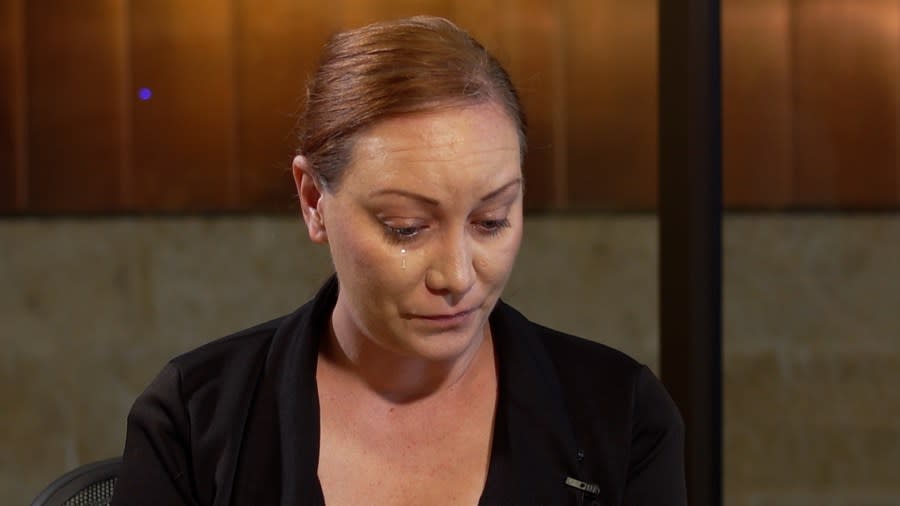
“Can we initiate an ordinance change that requires any new builds of hospitals, or places where people seek medical attention to have these types of protections?” she asked, referring to the steel posts designed to prevent vehicles from crashing into buildings or people.
A former volunteer firefighter who worked in health care, Kelly called bollards “a very easy fix” that can save lives. The McCue Corporation, which makes bollards for companies across the country, including H-E-B, said it would cost around $30,000 to install 20 crash-rated bollards at a hospital entrance.
Nadia and Levi Bernard were inside the lobby at St. David’s North Austin Medical Center looking at an aquarium with their two toddlers when a white Acura barreled through it, injuring them all. Nadia is still in a wheelchair. Their 2-year-old son has hundreds of stitches in his head and is being monitored for a brain injury.
The family hired an attorney and are expected to file a lawsuit against St. David’s related to not having bollards in place at the time.
Police are still investigating the crash, which killed the driver.
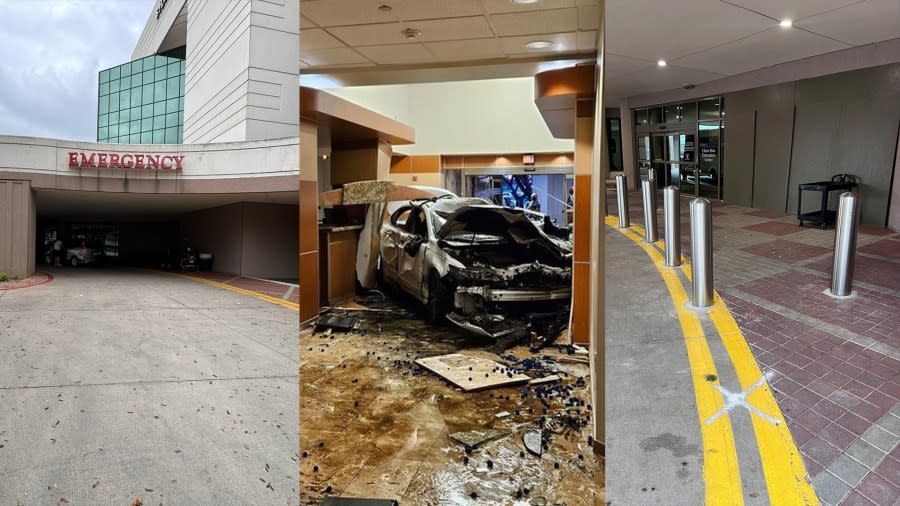
“The safety of our patients and their families, as well as our employees and visitors, is always our top priority,” St. David’s HealthCare previously said in a statement, adding, per policy, “we do not comment on pending claims or litigation.”
Asked about potential policy changes, St. David’s HealthCare said it “will work with policymakers and officials to ensure compliance with any new laws if they are passed.”
KXAN asked Kelly what she would say to the Bernard family.
“Your tragedy, hopefully, will save other lives and prevent that from occurring (again),” Kelly said. “But, there is no excuse for the pain your family has felt, and I wish I could give you all big hugs.”
‘Ensure this never happens again here in Austin’
“Oh my gosh,” Council Member Fuentes said as she watched KXAN’s report, at one point putting her hand over her mouth in shock. “Wow.”
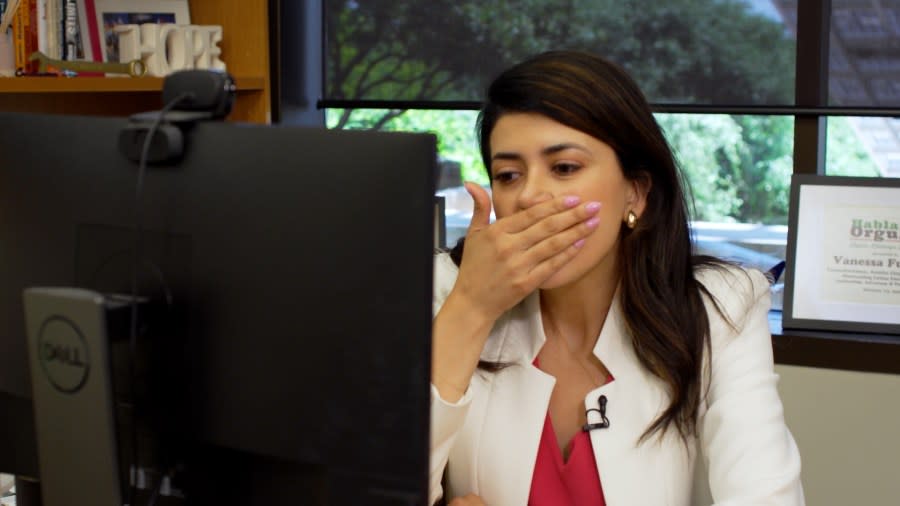
“Thank you all for covering this,” she said afterward. “I appreciate you all doing this type of investigative journalism because that exactly … is why we need policies updated.”
Fuentes called what happened at St. David’s “heartbreaking.” Now, she also wants to require bollards, but not just at hospitals.
“We want all of our hospital systems, all of our critical infrastructure, our nursing facilities, anywhere where there’s a lot of people moving in and out of,” Fuentes said, “We need to start looking at how are they designing their buildings with safety in mind.”
Asked if she would look into changes to address that, Fuentes quickly responded: “Yes.”
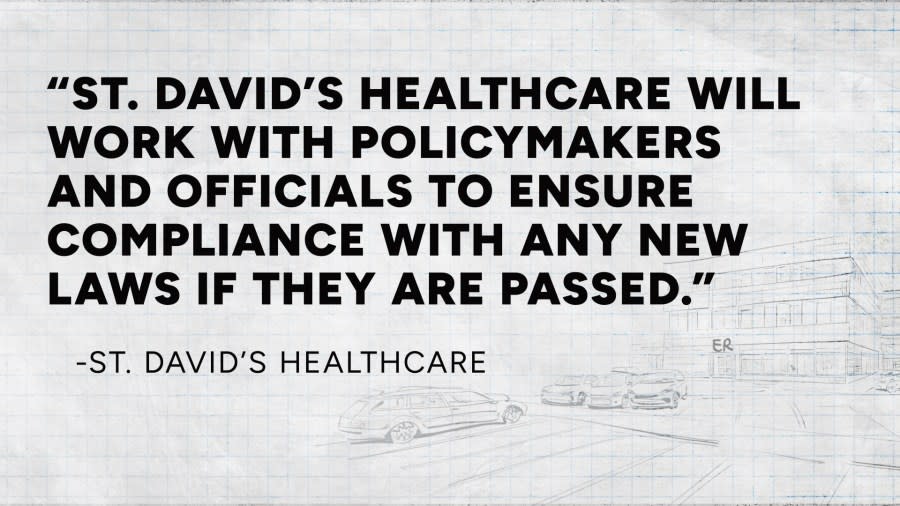
“We’re looking at a potential zoning change, any update to our land development code, any type of regulation where it makes sense that the city could really ensure that we have these safety measures in place,” Fuentes said. “And, to me, that’s what local government is all about, is ensuring the safety of our communities.”
KXAN also asked Fuentes what she would say to the Bernard family.
“I’m so sorry for the horrific experience that you’ve had, knowing that their children were injured, that the family was injured themselves … it’s just horrifying,” she said. “I hope that by us taking action, by bringing forward a policy that seeks to ensure this never happens again here in Austin, that that brings some semblance of relief for them knowing that their experience, their horrific experience, has not gone without any action being taken to prevent it.”
WATCH: Crash-testing bollards at Texas A&M Transportation Institute
Current city policy “does not prohibit hospitals or other businesses from installing bollards,” a City of Austin spokesperson said after KXAN asked the city manager for a comment. Any new policies or requirements “wouldn’t impact current facilities, only future ones” and would require a transportation code change if bollards are placed in a right-of-way, the spokesperson added.
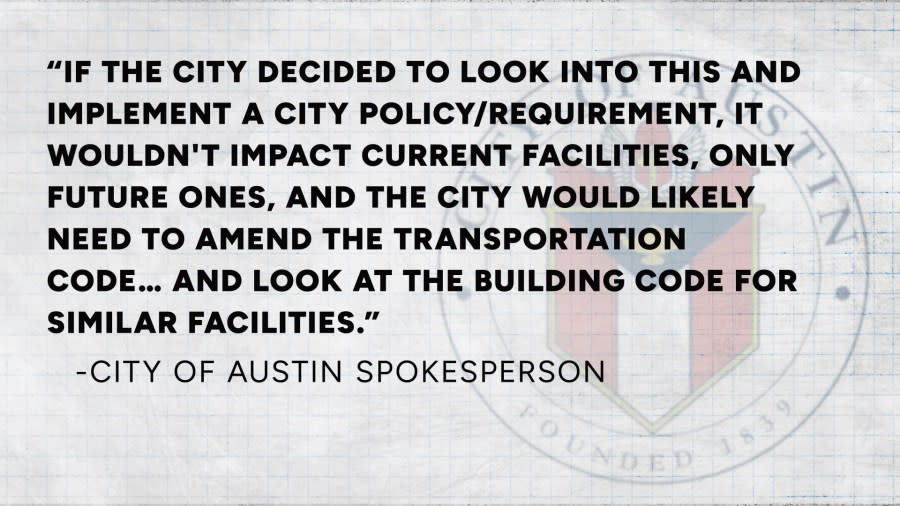
The Austin Transportation and Public Works Department said its focus is on the public right-of-way and anything to do with installing bollards on private property, like ER entrances, is not within its “typical purview.” The city is “generally supportive of initiatives which increases safety related to motor vehicle crashes,” a spokesperson added.
The Austin Code Department suggested KXAN contact other agencies that work with public safety saying they “may have more insight or relevant information regarding this issue.”
KXAN also reached out to Austin Mayor Kirk Watson. A spokesperson said they would “review this” with the mayor. We will update this story with any additional responses we receive.
Other cities took action following deadly crashes
Austin wouldn’t be the first place to consider policies surrounding safety barriers.
A Flourish map showing some cities with safety barrier ordinances. Source: Storefront Safety Council (KXAN Interactive/Dalton Huey)
Over the past decade, the SSC has worked to help pass local ordinances requiring crash-rated “vehicle impact protection devices,” like bollards, in business parking lots in five cities and counties. Some specifically addressed protecting outdoor public seating areas. Three were sparked by deadly accidents:
A 6-year-old was killed in a crash at a dentist’s office in Midfield, Alabama in 2017.
A 73-year-old was killed in a crash at an ice cream shop in Artesia, California in 2014
A 4-year-old was killed in a crash at a daycare center in Orange County, Florida in 2014.
The SSC helped local policymakers with ordinance language requiring the bollards be crash-rated to the same standards used during tests KXAN watched at the Texas A&M Transportation Institute. The language also made sure they comply with the Americans with Disabilities Act.
“Experts in vehicle-into-building crashes indicate that standard parking lot wheel stops and raised sidewalks are not sufficient, by themselves, to stop the force of a vehicle in such pedal error accidents and that other design standards and devices are needed to protect pedestrians, shoppers and customers,” read part of one ordinance in Artesia, California the SSC helped develop following a deadly crash at an ice cream shop in 2014.
In 2022, the state of California updated a law allowing insurance companies to offer discounts to businesses that install vehicle safety barriers “to protect pedestrians” from motor vehicle collisions.
Fuentes’ office has already reached out to the SSC to “collaborate on a policy in Austin.” In response to a KXAN investigation, her office said they are interested in “putting forth policy to require safety devices in front of hospitals and businesses to prevent crashes,” according to an email shared with KXAN.
‘Welcome the opportunity to collaborate with lawmakers’
Following the crash at St. David’s North Austin Medical Center, KXAN visited 34 major hospitals with emergency rooms in Central Texas. We found 18 hospitals had bollards, nine had partial coverage and seven had none. In Austin, four had partial coverage.
Most of the hospitals KXAN visited in the Austin area were owned by St. David’s HealthCare, Ascension Seton or Baylor Scott & White Health. We reached out to each hospital group about potential policy changes that could require bollards.
“Ascension Seton works with policymakers on various issues regarding the health and safety of our employees, patients and their families,” Ascension Seton said in a statement. “We will work with officials to ensure compliance with any new laws.”
“The health and safety of our patients, visitors and staff continues to be the highest priority for our health care system,” Baylor Scott & White Health said in a statement. “We appreciate the continued conversation on safety measures and welcome the opportunity to collaborate with lawmakers.”
Weeks before the crash at St. David’s North Austin Medical Center, vehicles drove into two Baylor Scott & White medical centers in Navasota and College Station.
State lawmakers eyeing action
Fuentes said she wants to see “uniform regulations” at the state level when it comes to bollards.
In the past three decades, Texas lawmakers have filed more than 101,000 bills, according to the Legislative Reference Library. While many dealt with public safety, a review of those bills found none appeared to have ever proposed rules regarding bollards outside buildings, a KXAN investigation found.
That could change in the next legislative session.
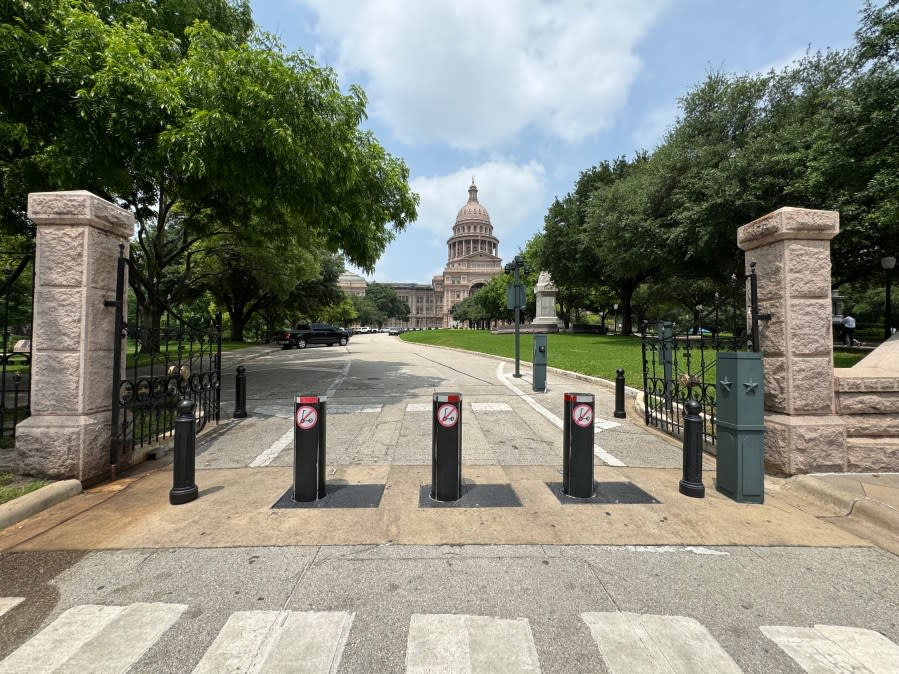
KXAN reached out to more than 50 state lawmakers who sit on transportation or health-related committees or represent districts with prior crashes involving medical centers.
In the week since our first report, more than a half dozen lawmakers have responded and indicated this is an issue they want to look into during the next legislative session:
The chief of staff for Sen. Sarah Eckhardt, D-Austin, who sits on the Senate Committee on Transportation, told KXAN: “We have put this issue on our legislative ideas to research.”
The joint chief of staff for Rep. Donna Howard, D-Austin, told KXAN their office is “reviewing materials and doing some research of our own too.”
A senior adviser to Rep. James Talarico, D-Austin, said their office will “further review” our findings. “We appreciate all your work producing such a thorough investigation and for focusing on this important issue,” Talarico’s adviser said.
Aides to Sen. Borris Miles, D-Houston, asked to see our data.
The chief of staff for Rep. Venton Jones, D-Dallas told KXAN, “Thank you for bringing this to our attention” and said he would discuss it with the representative.
Aides to Sen. Royce West, D-Dallas, are looking into our findings.
In the last legislative session, Sen. Bob Hall, R-Edgewood, invited investigator Matt Grant to testify in front of the Senate Committee on Health and Human Services about a KXAN investigation into the Texas Medical Board. Hall co-sponsored a bill, which became law, to reform the TMB based on our findings. Now, in response to our investigation into hospital safety, his chief of staff said she will “visit with the Senator on this idea.”
Other agencies contacted
KXAN also reached out to several state and national organizations that represent healthcare workers.
The Texas Health and Human Services Commission, which regulates health care facilities “has no plans at this time to make rule changes that would require bollards at hospitals,” HHSC spokeswoman Jennifer Ruffcorn said.
The Texas Medical Association has no policies regarding bollards and, therefore, has “no formal position” for or against them.
“Naturally our physician members want patients to be safe and healthy,” TMA spokesman Brent Annear said, “especially in places to which they go for health care and healing.”
The Texas Nurses Association, Texas Hospital Association and Capital Area of Texas Regional Advisory Council did not respond to our latest requests for comment. Gov. Greg Abbott’s office also did not respond. The American Hospital Association declined to comment. We will update this story with any statements we receive.
The Texas Nurses Association previously said it encourages all healthcare organizations to “seek evidence-based protocols and procedures that create a safe environment for their staff and patients.”
The Austin EMS Association, which represents more than 500 emergency medical services professionals, previously called bollards a “cost-effective” security measure and said they “could have helped” if they had been in place at St. David’s North Austin Medical Center on the day of the fatal crash.
“I do think that this event will potentially change some infrastructure for a lot of the hospitals in the area,” Austin EMS Association President Selena Xie previously said.
KXAN asked Xie what she thought of potential measures to require bollards at hospitals.
“We don’t have any specific thoughts besides supporting them,” she said.
On Wednesday, the Bernard family reacted to Kelly and Fuentes’ calls for new measures to improve hospital security.
“Nadia cried when she heard that news that lawmakers are taking this seriously,” Levi told KXAN in an email. “[A]mazing how quickly your story is getting attention.”
KXAN Investigative Photojournalist Chris Nelson, Graphic Artist Wendy Gonzalez, Director of Investigations & Innovation Josh Hinkle, Investigative Producer Dalton Huey and Digital Director Kate Winkle contributed to this report.
Copyright 2024 Nexstar Media, Inc. All rights reserved. This material may not be published, broadcast, rewritten, or redistributed.
For the latest news, weather, sports, and streaming video, head to KXAN Austin.


